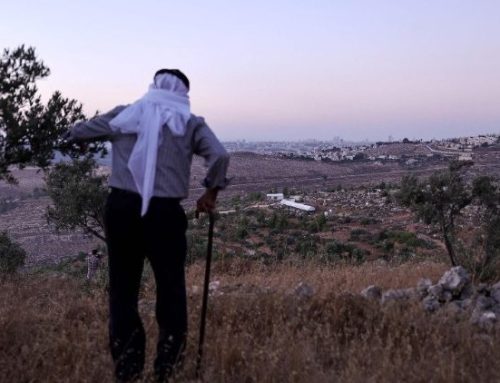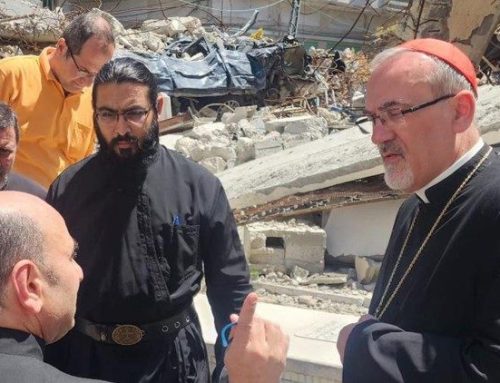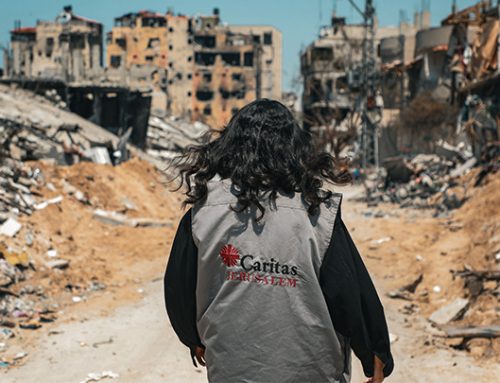Thine be the glory, risen, conquering Son, Endless is the victory thou o’er death hast won!
Thine be the glory, risen, conquering Son, Endless is the victory thou o’er death hast won!
Maccabeus Easter Hymn
* The Entry into Jerusalem!
They took palm branches and went out to meet him, shouting, Hosanna!
Jn 12:13
Over the past week, I have come across a number of initiatives, articles, letters and documents purporting to address the blood-curdling events unfolding in the Holy Land. Starting with 25 March 2002, I saw the Open Letter addressed to General Colin Powell, US Secretary of State, by members of the English-speaking Christian communities in the Holy Land. I then read with interest the comprehensive analysis in the Newsweek magazine Special Report (1 April 2002) on the future of Israel and its survival in the region. On 28 March 2002, I followed with implausible appreciation the success of the Arab League Summit in Beirut that turned the Saudi proposal into a pan-Arab Peace Plan with Israel. Finally, I read the Common Easter Message issued by the Patriarchs and Heads of Churches in Jerusalem as well as the thoughtful Easter Message dated 31 March 2002 by Patriarch Michel Sabbah on behalf of the Latin-rite Roman Catholic Church in the Holy Land. All this happened when some Israelis and Palestinians – Jews, Christians, Muslims – had undertaken a valiant but short-lived fasting initiative at the Bethlehem check point as a non-violent stand against the horrific tragedies that have bruised the two peoples and three religions of this blood-splattered land.
Written with great concern, sensitivity and balance, the Open Letter to Secretary Colin Powell captured the collective wisdom of those English-speaking Christians who have lived in the Holy Land for many years. Their letter condemned terrorism and rejected violence as a means of advancing the political cause of the Palestinians. It fully recognised the right of the Israeli people to live in peace and security in their own state. However, it also enumerated the wide range of Israeli violations of Palestinian basic human rights and personal freedoms which have led to the emergence of a strong sense of moral outrage within the Palestinian, Arab and Muslim worlds. It appealed to the US Administration to display a type of ‘tough love’ for both battle-weary peoples by addressing this conflict in a manner that recognises the international legality of UNSC resolutions 242, 338 and 1397 and secures a just and lasting peace.
The pan-Arab Peace Plan was an equally encouraging development in that the Arab world laid out clearly for the first time its terms of reference for any future negotiations with Israel. Succinctly put, the plan based itself upon the principle of land for peace. It demanded an Israeli withdrawal from the occupied Arab territories, the establishment of an independent and sovereign Palestinian state with East Jerusalem as its capital and the attainment of a just solution for the Palestinian refugees in accordance with UNSC Resolution 194. In return, the Arab world pledged to sign a peace agreement with Israel and establish normal relations with it within the framework of this agreement. This new ‘land for peace’ deal offered at long last a way of healing the suppurating sore of the Israeli-Palestinian conflict.
* A Crucifixion of Violence!
When they had crucified him, they divided up his clothes by casting lots!
Mt 27:35
The suicide bomb attack against Israelis last week during a Jewish Passover meal in Netanya led to the start of this latest chapter of reprisals, mayhem and carnage. As in all violence in general, attacking Jews at the very moment when they were recalling their own crossover from slavery in Egypt was a totally pernicious act of violence. It was quite clear that Israel – and particularly its hawkish leader – would retaliate in the most punishing manner possible. However, PM Ariel Sharon’s ferocious and personalised retaliatory aggression has complicated even further the configuration of any peaceful process between the two peoples of this land for the foreseeable future. This deliberate attempt to dismantle the infrastructure of the Palestinian Authority and marginalise its leader will not bode well for the future welfare of both peoples. It will fan the flames of hatred, and stoke the sense of vengeance that will now grow even more harshly within the Palestinian communities that are being crushed under the unrelenting blows of the Israeli army.
Writing in the Independent daily newspaper on 30 March 2002, the investigative journalist Robert Fisk ponders, ‘how much longer can Ariel Sharon pretend that he is fighting in the war against terror? How long are we supposed to believe in this nonsense? How much longer can the Americans remain so gutlessly silent in the face of a vicious conflict? Terror, terror, terror! Like a punctuation mark, the word infects every Israeli speech, every American speech, and almost every newspaper article. When will someone admit the truth that the Israelis and Palestinians are engaged in a dirty colonial war that will leave both sides shamed and humiliated?’
Fisk’s article also draws some uncomfortable analogies. It states that Arafat and Sharon share a lot in common. They both are old, ruthless, cynical, and despise each other. ‘Sharon’, Fisk avers, ‘believes that the Palestinians can be broken by military power. He does not realise what the rest of the world learnt during
* The Sponge of Vinegar!
One man ran, filled a sponge with wine vinegar, put it on a stick and offered it to Jesus to drink!
Mk 15:36
Has the Israeli-Palestinian conflict descended into an abyss of egregious personal humiliation? How can this attitude become condonable within the cultural sub-context of the Middle Eastern region? During the whole length of this latest chapter of fratricidal violence, two things have surprised me constantly. One has been the expectation by Israel – and America – that Chairman Arafat can actually quell the violence whilst at the same time lying in a state of total siege. The other has been the degree of personal vindictiveness that has permeated the politics of the region, whereby the elected leader of a proud people is humiliated intentionally in front of his own people and the whole world!
Many commentators have compared this vinegary sense of tit-for-tat killings with Northern Ireland, perhaps more so since the events of this week also coincide with the fourth anniversary of the Good Friday Agreement. Yet, these two conflicts are not necessarily comparable. True, there are many delusive similarities between the two situations. After all, one people took land from another, a two-state solution was agreed upon but failed to settle the issue, and a minority on one side resorted to terrorism and provoked a punitive reaction that increased support for more violence. In both cases, cease-fires lived and died, talks started and halted, and Senator George Mitchell delivered his report.
However, the differences are more striking than the similarities. The IRA never resorted to suicide tactics, whilst the British government – although straying occasionally into ‘shoot to kill’ – never adopted a policy of targeted assassinations. But the differences go even deeper than the mere tactics deployed by either side. The styles of thought that brought the IRA to realise that it could better further the interests of its people by peaceful means are Western, secular and Marxist-orientated. Those driving the leaders of Fatah and Hamas today to send their foot soldiers to kill Israeli citizens at random are predicated on a religious belief in self-immolation and martyrdom.
Equally, the attitudes of the Israeli people are unlike those of Northern Irish Protestants, just as those of the Israeli government are totally unlike the pragmatism of the British government. The horrors suffered by Jews in the last century, and the psychology of a tiny and isolated Jewish state fighting for its existence, are still very palpable and real.
To the extent that it is possible to make broad generalisations about both situations, those attitudes only emphasise how apart both sides have erred today. I believe two things made peace possible in Northern Ireland. For one, both sides felt they had an interest in a settlement. For another, there were individuals from both sides who showed real and proactive leadership. Those two conditions are not generously met in the Holy Land. The Israelis feel – rightly or wrongly – that they have tried negotiation but that the Palestinians rejected their offer. They therefore believe that the only option is to try controlling the Palestinian ‘extremists’ by force. They are sorely mistaken, not in principle but in practice, although it may take many more awful deaths for the ineffectiveness of even-heavier repression to become evident. The Palestinians, meanwhile, are becoming increasingly – worryingly – more prone to the nihilistic appeal of a holy war.
* The Resurrection of Hope!
They found the stone rolled away from the tomb, but when they entered, they did not find the body of Jesus!
Lk 24:2
Much has been written or said about the violence that has racked the Holy Land for the last eighteen months. Many politicians and commentators have bemoaned the Palestinian proclivity toward violence, and stressed the need to stop this vicious cycle. After all, the emergency meeting of the UN Security Council on 29 March 2002 voted on the Norwegian-sponsored resolution that aimed to halt the fighting. Passed by 14 votes to nil – and supported by the USA – Resolution 1402 called on both sides to work toward a meaningful cease-fire and the withdrawal of Israeli troops from Palestinian cities. The Resolution also urged both sides to co-operate with US-appointed mediator Anthony Zinni and to halt ‘all acts of terror, provocation, incitement and destruction’.
Much as I endorse this irenic resolution, and pray for an Easterly cease-fire between the two warring parties, I cannot forget that the crux of this whole problem is not one of violence for the sake of violence. This violence is associated directly with thirty-three years of an illegal and debilitating occupation of Palestinian land by Israel. To end this cycle of violence necessitates putting an end to the occupation itself. But here again, opinions differ on the methodology of the process – perhaps a reminder of what Tolstoy did [not] say that processes differ although peace remains the same!
In the Newsweek Special Report, Dr Henry Kissinger argued knowledgeably that the USA could not engage in mediation unless both sides realise that the only feasible goal is a limited settlement. Each side, he wrote, will achieve less than its maximum aim but more than it can accomplish by a continuation of the conflict. Under present circumstances, Kissinger added, this implies that a cease-fire must accompany negotiations, and that negotiations must aim for less than a final settlement The goal for such an agreement would be to secure borders with contiguous territory for an independent Palestinian state. As part of the necessary withdrawals, Israel must be prepared to abandon outlying settlements. However, issues other than the border between the two states would be left for later negotiations.
Former British Foreign Minister Douglas Hurd propounds a contrary view. Writing in the Financial Times on 26 March 2002, he states that piecemeal solutions are no longer effective. He suggests a Dayton-type conclave where both parties will be ‘cajoled’ into a settlement. In its own way, the Open Letter from Jerusalem also supports this viewpoint when it states that it is no longer ‘appropriate’ to discuss proposals about interim solutions or arrangements. In fact, I think that the seven-year long Oslo process has proven that protracted, delayed settlements do not yield any peace – or even any tangible morsels for that matter! They merely raise expectations at an early stage only to exacerbate tensions later.
* The Great Commission!
Go into the world and preach the good news to all creation!
Mk 16:15
In a region riven by unreason, intolerance, fanaticism, hatred, intransigence and despair, it is perhaps helpful to become introspective and to ask oneself Lenin’s famous humanist phrase ‘What is to be Done?’
The Common Easter Message from Jerusalem expresses deep concern for the hungry, the homeless, the unemployed and the killed or injured within all communities. But it offers meagre hope for the dark moments being experienced by both peoples today. Perhaps we should take a leaf from Patriarch Michel Sabbah’s Easter homily inviting Christians to be ‘patient, strong and persevering until the trials are over’. Bishop Christopher Herbert of St Albans also echoed this message in his Easter sermon when he stressed that the Gospel of Peace offers a solution to the conflicts of the world. Indeed, following their initial meeting at Alexandria in January 2002, Jewish, Christian and Muslim leaders are meeting regularly in the sanguine hope of reaching a common vision that manifests God’s justice and love.
Christians are celebrating the Resurrection of their Lord, a miraculous event that symbolises the enduring permanence of hope. But will the Ascension into a peaceful settlement follow suit? Frankly, I dread to answer that question today!
Then they worshipped him and returned to Jerusalem with great joy!
Lk 24:50
(c) harry-bvH @ 1 April 2002





